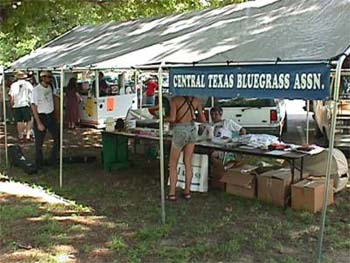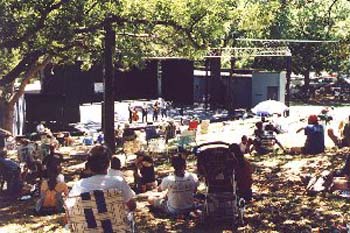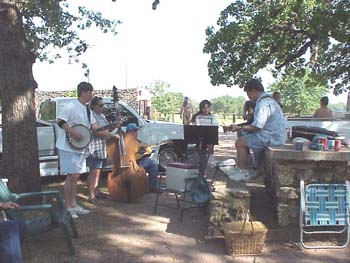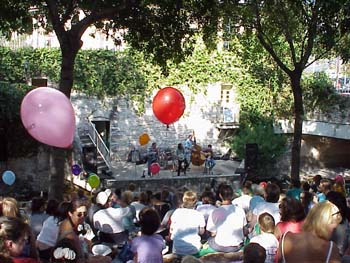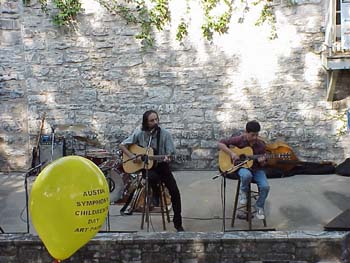History of the CTBA
By Ken Brown
From the Bluegrass Bulletin, 2002
Even if you’ve noticed the “1978” in the association’s logo, or if you’ve noticed that this issue is part of Volume 25, the significance of that may have escaped you. Well, the CTBA is now 25 years old, presumably placing it among the oldest local and regional bluegrass associations in the country. Steve has asked me to write this retrospective essay, perhaps because I’m a relic of the past myself, and in it I intend not only to review some of the association’s history, but also to assess where we stand as an organization. We have a distinguished history of faithful support for bluegrass in Central Texas, and it won’t hurt to review some past accomplishments. As I type, I’m listening to my favorite Internet bluegrass DJ, Lisa Kay Howard, on BluegrassCountry.org, and that helps speed the task along. If you’re interested in local bluegrass history, I’d also like to remind you of the comprehensive two-part history of Austin bluegrass bands published by Tom Ellis in the February-March and April-May, 1988 issues of the Bulletin.
Late 1970s: Founding and Early History
The story actually starts seven months before the founding of the CTBA, when Austinite Don Rodgers (1933-1990) started a privately published monthly “Bluegrass Newsletter.” The first issue was published in April, 1977. At that time, the chief umbrella organization for acoustic musicians was our sister association, the Austin Friends of Traditional Music (also still going strong, by the way), which hosted an open mike at the old Rome Inn on 29th Street. This was the chief jamming outlet for Austin-area bluegrass pickers. Before that, the AFTM sessions had been held at the Crazy Horse Saloon (on Cameron Road). These places, along with the beloved Split Rail on South Lamar (see photo; now the site of a Wendy’s burger joint) were the hotspots for bluegrass jamming. And believe it or not, Austin already had a bluegrass radio show “Bluegrass Breakdown” on KUT-FM, hosted by Terry Lickona, now the producer of Austin City Limits. The principal Texas bluegrass festivals were at Kerrville, McKinney, Buffalo Gap, Perrin, and Glen Rose (Oakdale Park).
The first planning session for a proposed Central Texas Bluegrass Association took place on October 12, 1977. Attending were Rod and Nancy Kennedy, Bob and Joyce Barton, Ken McCormick, Ted and Carla Miller, Frank Jennings, Don Rodgers, Judy Minshew, and Pete Nichols. Ted Miller was the chief sparkplug for the founding of the organization. The charter membership convention took place on January 22, 1978, at the Tumbleweed Restaurant, (now the County Line restaurant on the hill, FM 2222 west of Loop 360; see photo). Rod Kennedy was the MC for a crowd of 120 people (61 of whom signed up to become charter members), and seven bands performed: Backyard Bluegrass, Grassfire, Southern Select, the Poverty Playboys, the Broken String Band, Southwind, and No Money Down (the band that I was in at the time). There was a general membership meeting, Ted Miller was elected chairman, and a board of directors was elected (including Tom Pittman and Wayne Ross). The following month was marked by the beginning of the official CTBA jam (first and third Sundays), at St. Michael’s Episcopal Church, on Bee Cave Road, a jam session that was to persist at the same location for the next 12 years. Since Don Rodgers already had an existing Texas-oriented bluegrass newsletter in existence, the board of directors worked out a contractual arrangement in which Don’s publication was to be distributed as a benefit of membership in the CTBA. This arrangement persisted for ten years, until the association started its own newsletter in 1987. Only a few months old, the CTBA co-sponsored (along with the Kerrville Music Foundation) its first public bluegrass concerts in Kerrville (McLain Family Band, Buck White and the Down Home Folks) and at the Paramount Theater in August, where fiddler Jana Jae was the headliner and 600 people turned out. And 1978 also marked the founding of Leon Valley Bluegrass, a longtime CTBA band.
The second annual meeting of the CTBA took place on February 4, 1979 at the Alamo Roadhouse, which is now the other County Line restaurant, the one on Bull Creek. Continuing the precedent set at the first meeting, several bands performed: Lower Forty Bluegrass (from Alabama), Leon Valley Bluegrass, Blue Blazes (featuring among others, Tim Wilson), the Poverty Playboys, and No Money Down. Somewhere, I still have a cassette of part of those shows. Ed Garner was elected as the new president. At this point in the incipient history of the organization, a significant proportion of the members actually showed up at the annual meetings. I can’t find any attendance figures, but I seem to recall a decent-sized crowd. The CTBA’s charter still provides for an annual meeting (the last one was December 1, 2002), but hardly anyone shows up any more. Of course, we don’t offer free beer and pizza. What were we thinking?
On April 1, the association co-sponsored (with KOKE Radio, then a country station) another concert at the Silver Dollar South with Leon Valley, the Poverty Playboys, Grassfire, and Southern Select.
The 1980s: Bluegrass Boomtown
In January, 1980 the Bluegrass Newsletter went to a bimonthly schedule, and in March, the CTBA held its third annual membership convention at the Opera House in Bastrop. The Board of Directors defined five goals for the association:
Buy a sound system to be used at CTBA concerts
Buy a banner for a membership booth
Build the treasury to $2000
Promote one show per quarter in small towns around Austin
Pay bands for playing
The “Bluegrass Breakdown” program on KUT-FM was cancelled, and Bill Monroe played the Armadillo World Headquarters (November 19, 1980); the band included Kenny Baker, Wayne Lewis, Butch Robins, and Mark Hembree. I shot up an entire roll of black and white film and managed to get some good photos of Bill and the Blue Grass Boys. About this time, I moved to San Antonio, and for the next eight years, my knowledge of CTBA happenings is derived mostly from the newsletter. In July 1981, Jamie MacLaggan took over as editor and publisher of the Bluegrass Newsletter, beginning with Volume 5, number 4. The CTBA continued to promote shows at the Bastrop Opera House in the summer of 1981, and it was about this time that the CTBA’s logo first appeared in print. The mandolin-shaped logo was drawn by Austin dobro picker Leonard Kasza. During the early 1980s, the events calendar began to expand somewhat, and it’s clear that there were more venues supporting bluegrass, and more special events in the Central Texas area. The CTBA continued to promote concerts at the Bastrop Opera House. In October, 1982, Dave Marcum launched a new radio program, “Bluegrass Sunday Morning,” on KVET-AM, in effect a forerunner of the current “Strictly Bluegrass” on KOOP-FM.
The CTBA probably achieved its high-water mark in 1984 and 1985 with the successful staging (in cooperation with the UT Bluegrass Association) of two “Bluegrass Winterfests” at the Performing Arts Center Concert Hall on the UT campus. The first of these, held February 10, 1984, featured the Doc Watson Trio with Sam Bush, Hot Rize, Doyle Lawson and Quicksilver, and the Fire on the Mountain Cloggers. And remarkably, 2200 of the 3000 seats in the auditorium were filled. On March 2, 1985, the second Winterfest was presented, with the Johnson Mountain Boys and the Whites featured.
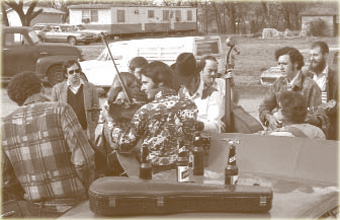
Jamming at the Split Rail circa 1976; Marshall Wilborn, Dennis McDaniel,and Bernard Molberg can be identified behind the Ford Pinto in this photo. This is authentic “parking lot picking.” The brick building in the right background is the Paggi House.
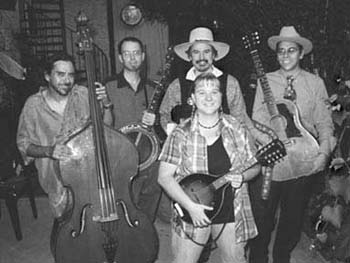
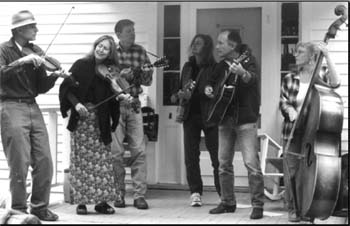

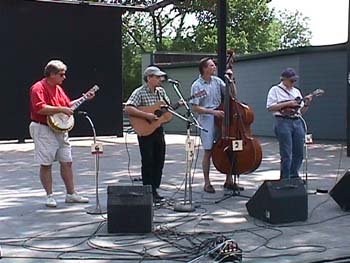
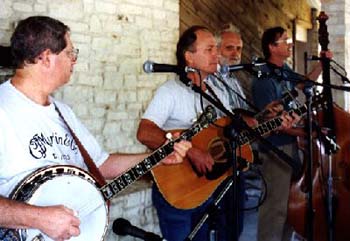
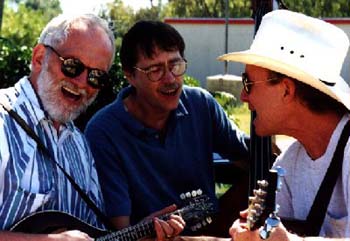
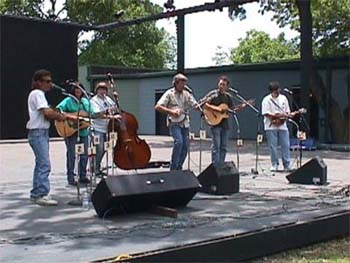
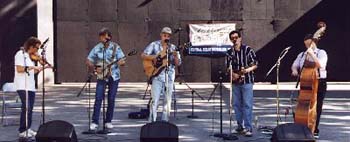
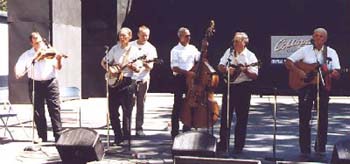
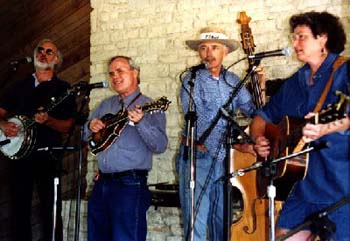
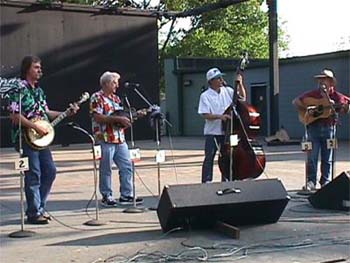
Since I lived in San Antonio, I was not involved in any of the planning or execution of these concerts, but I can well imagine what a staggering undertaking it must have been to produce two events on this scale. All I can tell you is that both years, when I walked into the auditorium and saw the immense turnout, I was amazed. And the shows themselves were unbelievably good. This was truly the CTBA’s finest hour, and the association officers ought to be enshrined somewhere for their efforts. In many ways, the middle and late 1980s were boom times for bluegrass in Central Texas and elsewhere. The newsletter was upgraded and expanded, there were more local events, the Kerrville Bluegrass Festival continued to bring in major talent like Hot Rize and the Whites, and promoter Jane Lancaster staged a series of Nacogdoches Summer Music Festivals with acts like the Seldom Scene, Osborne Brothers, Hot Rize, Newgrass Revival, Nashville Bluegrass Band, Tony Trischka and Skyline, J. D. Crowe and the New South, Jerry Douglas, the Tony Rice Unit, the Bluegrass Cardinals, and others. It seemed that almost every major act in bluegrass was there, and it was at one of these that Pete Wernick ventured out into the campground one evening and spent the night picking with a bunch of us rank amateurs. In the winter, Jane also staged indoor festivals termed “Acoustic Music Conventions.” In September, 1988, the final Kerrville Bluegrass festival took place and in October, the first Old Settlers Bluegrass Festival was held in Round Rock, sponsored by the Old Settlers Association, City of Round Rock, and Round Rock Chamber of Commerce. The following year, I saw Alison Krauss and Union Station for the first time at the second festival.
In September 1984, “Bluegrass Sunday Morning” was cancelled. In May, 1984, the CTBA and Ted Miller took over publication of the Bluegrass Newsletter from Jamie MacLaggan, maintaining both the name and the current issue numbering of the publication (the next three issues lack the year of publication). The CTBA also established a new “north” jam at Old Settlers Park on weekends that alternated with the St. Michael’s jam. In October, 1986, the “north” jam moved to Cap’n Tom’s Barbecue. I believe Rolf and Beate Sieker made their first visit to Austin in January of 1985, and later that same year, the IBMA was chartered (in 1992, the CTBA joined as a member organization).
In 1986, the first Tres Rios festival was held featuring, among others, Blue Night Express. Didn’t a couple of those pickers eventually become Dixie Chicks?
In 1987, the final issue of the Bluegrass Newsletter was published (April-May, Volume 11, number 2) and in May, the CTBA established the Central Texas Bluegrass Bulletin to fill the void left by the demise of the Bluegrass Newsletter.
This is the first publication that the association could truly call its own (and the first to actually sport the association’s logo), and Jeanne DeFriese was the first editor. The first issue is undated, but was evidently issued in May. Eleven issues in 7 x 8.5-inch format were produced at irregular intervals, the last being the December 1988/January 1989 issue. The date was listed, beginning with the second issue, but no volume or issue numbers were listed. Beginning with the February-March 1989 issue, the Bulletin went back to a standard 8.5 x 11-inch format, very similar in appearance to the Bluegrass newsletter, but with the logo on the masthead. Volume and issue numbers were still omitted throughout 1989, until the February/March 1990 issue was published as Volume 12, number 1. The numbering, in other words, was resumed in such a way as to make it consistent with its predecessor, the Bluegrass Newsletter. CTBA member Buck Buchanan handled the printing of the Bulletin, and would continue to do so for the next ten years, earning himself a place in the CTBA Hall of Honor.
On May 7, 1988, the association celebrated its 10th anniversary and Worldwide Bluegrass Month by staging the first of eleven annual outdoor public concerts at Zilker Hillside Theater. Wrygrass, the Barnburners, the Grazmatics, Texas Prairie Fire, the Buchanan Brothers, Leon Valley Bluegrass, and the Flaky Biscuit Boys played. In 1990, Don McCalister suggested that the CTBA issue a compilation recording representing all the member bands, to raise funds for the CTBA. Now, 13 years later, it looks as though that idea is going to assume concrete form, as the association issues its first compilation CD.
The 1990s: Zilker and Old Settlers
In June, 1990, the CTBA biweekly jam ended its twelve-year run at St. Michael’s Church, leaving the “alternate north” jam session at Cap’n Tom’s Barbecue on north Lamar (now Ross’s Old Austin Café) as the official CTBA jam, and starting a tradition of “barbecue and bluegrass” that continues in Austin to this day. Tom Allen, the North Carolinian ex-tugboat captain, served as our genial host for the next year and a half. Large measures of bluegrass were picked on the wraparound porch, and stage shows featuring acts like the Weary Hearts and Warrior River Boys were often held on a small open stage in the front yard. In about January, 1993, the jam moved to the Travis County Farmers’ market on Burnet Road and for the first time was held every Sunday.
In October, 1992, the CTBA sponsored a fall festival (with the Del McCoury Band) at Jellystone Park, near Waller. In December, John Hood became the editor of the Bulletin. In 1993, the association co-sponsored the Old Settlers Festival. This was the only year that the CTBA was formally involved with the festival, but because so many CTBA members continued to volunteer in subsequent years, and because the CTBA continued to hold its own events at Old Settlers Park, the festival was often erroneously associated with the CTBA in years to come. A show featuring Bill Monroe and the Blue Grass Boys was scheduled for June 12, 1994 at the Manchaca Fire Hall, but had to be cancelled. In July, 1994, the CTBA jam moved from the Farmers’ Market to Ruby’s Barbecue, on 29th Street. “Strictly Bluegrass,” hosted by Keith Davis and Rod Moag, went on the air on KOOP-FM in 1994. In 1995, the Board of Directors began seeking Cultural Arts funding for the Zilker show from the City of Austin. The grant was received and applied to the 1996 festival. In April, 1995, the CTBA jam moved from Ruby’s Barbecue to ArtZ RibHouse, where it remains today, and in July, the association began holding its annual “Fun Raiser” garage sale at ArtZ RibHouse to recover losses (about $500) from producing the Zilker festival and actually took in $863, far exceeding its goal. Some time around February, 1996, the CTBA web site went online. At the urging of editor John Hood, and beginning with the June, 1996 issue, the Bulletin was considerably downsized and changed from a bi-monthly to a monthly publication. Chuck Interrante became the new editor in November 1996, then Chuck Brodkin in April, 1997, Doug Stoker in July, 1998, and the present editor, Steve Zimmet, in March 2000.
For eleven years, from 1988 to 1999, the CTBA held its free outdoor concert series at Zilker Park Hillside Theater in May, through years with good weather and bad, subsidizing it through arts funding (in the early years) and the July “Fun-Raiser.” Rising use fees and declining city funding led the association to discontinue the Zilker fest in 2000. Instead, an association jam was held at Krause Springs in May, 2000, and a fall festival was held at Old Settlers Park (by this time, the “Old Settlers Festival” promoted by Randy Collier had moved on to Dripping Springs).
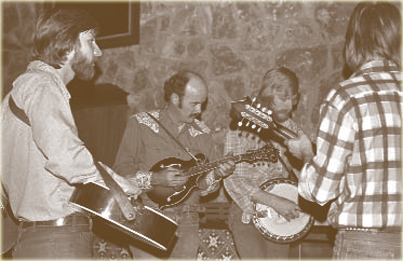
Jamming at the first CTBA membership convention (January 22, 1978) at the Tumbleweed Restaurant (now the County Line on the hill). Left to right, Dan Huckabee (dobro), Dennis McDaniel (mandolin), Chris Hirsch (banjo), Jim Schubert (mandolin).
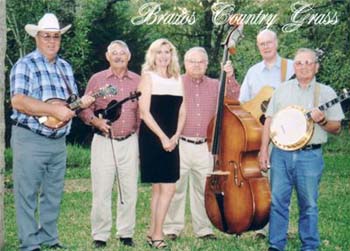
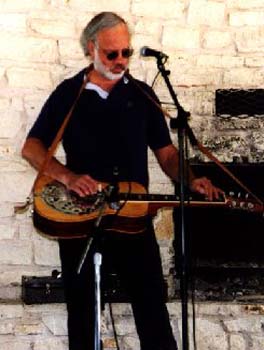
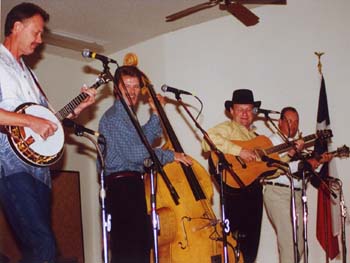

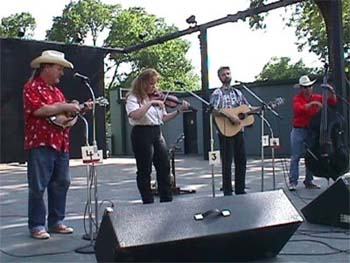
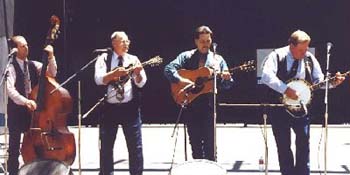
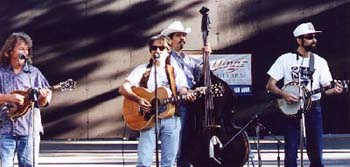
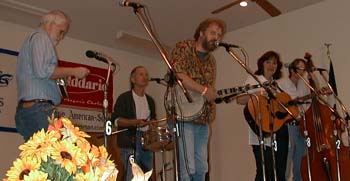
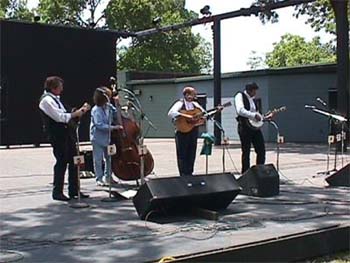
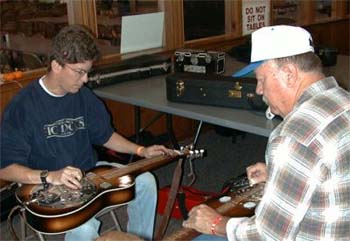
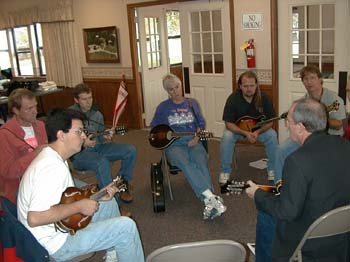
Unfortunately, a cold rain kept the crowds away in droves, and the audience was estimated at about 90 for the day. A fall “Pick-Nic” for members was also held at Quarries Park in northwest Austin from 1996 to 1999. Board members began to be concerned about the decline in the association membership (see the January 2001 issue of the Bulletin). In March, 2001, the Board met for a retreat to discuss goals and strategies for the association. A monthly meeting with a featured, paid band was suggested, as well as seeking grants and corporate donations for funding. In October, 2001 another fall festival was held at Old Settlers Park.
Membership: Growth and Decline
Central Texas has never been part of the bluegrass heartland. It is removed both culturally and geographically from the land of the banjo and the mandolin, and despite 25 years of strenuous effort by successive boards of directors, the membership has never grown to any great size. It probably peaked in the mid-1990s, but has declined since then, and we now have fewer than 150 members. I could find very few membership figures; these are all that I was able to locate (some are estimates):
1978 61 charter members
1988 230+
1992 219
1993 250
1995 312-325
1996 335
2002 147
Most of the major festivals are in East Texas, and even when the CTBA maintains a membership table, it is difficult to interest East Texas residents in joining a central Texas club. So far, I have seen no evidence that the Down From the Mountain Tour or the “O Brother Where Art Thou” soundtrack will reverse our declining membership.
Festivals, Concerts, and Workshops
As the above history reveals, the CTBA has presented an amazing array of live music during its 25-year history, beginning with the nascent organization’s very first annual meeting. This part of its mission statement has been well executed, with 11 years at Zilker, four years at the Quarries, several festivals at Old Settlers Park, and a variety of concerts by touring bands. The two major concerts at the Performing Arts Center in the mid-1980s were the climax of this effort.
The Weekly Jam Session
The jam session is another success story. It’s never been more healthy than it is right now. Pickers can show up at ArtZ RibHouse just about any Sunday and depend on finding an assortment of like-minded jam partners. Dependability and a good host are the key to a good jam session, and we have both. We have been very fortunate in having support from gracious hosts like Tom Allen, Art Blondin, and Zenobia Sutton. If you go to ArtZ to pick or listen to shows, buy something to eat. Art didn’t win all those barbecue cookoff awards on the walls for nothing, you know.
In reality, the CTBA doesn’t have to do anything to sponsor the jam session. ArtZ RibHouse supplies the location, and all we have to do is show up. For a time the CTBA had a semi-formal “jam coordinator” (Ron Wilbourn, and later Eddie Collins) whose job was to encourage new pickers and to try to break the session into subclusters when the circle got too big. I think the association would do well to reinstate this position. If there’s a drawback to the current jam, it’s that it’s usually too big. It’s not unusual to see 20 or more pickers in a circle trying to play the same tune, often without even being able to see one another. Tunes take 15 minutes to rotate around the circle. Someone needs to enforce cell division on the larger sessions.
Education and Promotion Functions
The growth of the association depends on new members, and that means reaching existing bluegrass fans who don’t yet know about us, as well as making new bluegrass converts. The CTBA has been struggling towards this goal for its entire life. As I remarked earlier, this isn’t really bluegrass territory. Most Central Texans are more familiar with Christina Aguilera than Mountain Heart. Even the sporadic appearance of Alison Krauss on KGSR’s playlist hasn’t really helped inform the public much, although I do think that radio is the best medium for reaching the public. See “Pitching Bluegrass to Commercial Radio” at http://ibma.org. Even as we speak, the IBMA is starting a new “Discover Bluegrass” marketing campaign. Maybe we need to get involved in that.
The Future
At times, it seems as though the CTBA is about to go under, either because bad weather has slammed the attendance at some heavily booked event, or because not enough willing volunteers can be found to do the hard work of the organization’s officers, or because not enough people are willing to fork over the $20 to become a member. But, take heart. It’s always been that way, as long as I can remember, and yet the CTBA has survived. Instead of using “In Despair” (the Stanley Brothers) as the CTBA theme song, maybe we should use “I’ve Endured” (Ola Belle Reed).
Some People to Thank
There are some folks we ought to acknowledge who have contributed more than their fair share to the CTBA. Of course, this is just the short list. It leaves out a lot of important names, but I think special mention should go to Ted Miller, who helped get the whole thing started; Buck Buchanan, who printed the newsletter for so many years; Tom Allen, Art Blondin, and Zenobia Sutton, our hosts; Shawn Spiars, our efficient webmaster; Steve Zimmet, our editor; and especially all of the current and past officers, who devote long hours without pay or even much appreciation from the membership.
Editor’s Note: This article was contributed and copyrighted by Ken Brown, 2002. Ken (dobro, guitar) is a native Austinite in the PhD program at UT Austin. Ken plays (mostly dobro) with the Blackland Prairie Boys. He says The Boys don’t let him sing in public, and he has the severed microphone cords to prove it.
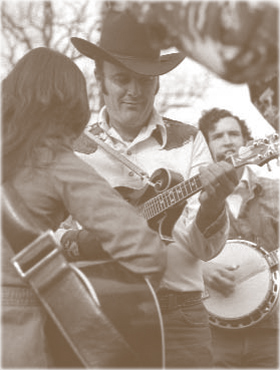 Jamming at the Split Rail circa 1976. In the foreground, Dennis “Hoot” McDaniel on the mandolin; in the background, Marshall Wilborn on the banjo.
Jamming at the Split Rail circa 1976. In the foreground, Dennis “Hoot” McDaniel on the mandolin; in the background, Marshall Wilborn on the banjo.
